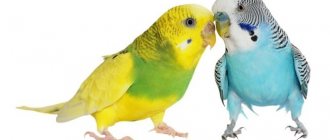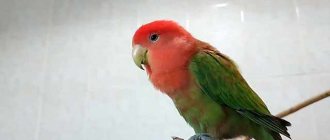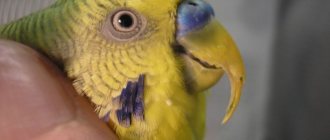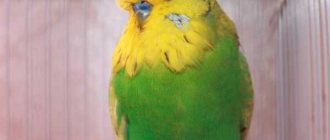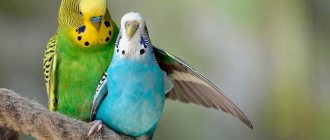From: Oksana Tel.: 8905
Message: Hello, my male budgerigar has been sick for more than a month and lives alone in a cage. There are no bird specialists in our city or nearby. Parrot, 3 years old. Every minute I began to excrete water separately from urine and feces, I read that this is definitely polyuria, the photo is very similar to our problem. The parrot is tired all the time, not cheerful, drinks a lot, eats a lot of grains (Prestige), and sometimes carrots.
Good afternoon With such symptoms, if possible, a biochemical blood test should be carried out, in terms of determining blood glucose and the amount of protein. Of course, other information about the state of the blood is also in demand, but unfortunately, in addition to a general blood test and the above parameters, we will not be able to do a more detailed blood test in budgerigars, since their circulating blood volume is extremely small for existing devices. Here you can also do an ultrasound of the kidneys to check for nephritis or glomerulonephritis, and the liver, which can also cause polyuria in a budgie. Also, in our experience, the hospital drugs Nephrogep and Sarcomin, which are given in alternating courses of 1-2 months through a drinking bowl, help with polyuria. The address where you can order drugs is as follows
Sincerely, Vladimir Romanov
Glomerulonephritis in a budgerigar
Pathological causes and risk factors:
- polycystic kidney disease;
- hydronephrosis;
- chronic pyelonephritis;
- renal failure;
- cystitis;
- urolithiasis disease;
- tumors in the pelvic organs;
- pathologies of the nervous system;
- endocrine disorders;
- diabetes insipidus and diabetes mellitus;
- pathologies of the thyroid gland;
- prostate diseases;
- arterial hypertension;
- paroxysmal tachycardia;
- heart failure;
- multiple myeloma.
Is your parrot healthy?
Appearance is the main thing!
First of all, you need to carefully monitor three aspects: the behavior of the parrot, its appearance and, of course, the droppings.
A healthy bird has smooth, even plumage: not dull or disheveled, without bald spots. The feathers are clean and not leaky. The area around the anus should also be clean, free of bald patches and droppings. The beak is smooth, without obvious cracks, delaminations, and especially growths. The supracervical cere is of its usual color and without pathological changes.
Cracks or other damage to a parrot's legs may also indicate that it is not feeling well. You should also pay attention to the eyes. They should not be cloudy, red, watery, and so on. It is easy to guess that any discharge from the respiratory tract is also an alarming symptom.
Like any animal, a sick bird dramatically changes its behavior. She becomes lethargic, drowsy, indifferent to what is happening around her. May refuse to feed and drink, sit with a ruffled or drooping wings, tremble, sneeze or cough. If a feathered pet constantly sits on only two legs, this may also indicate that it is not feeling well, since parrots, sitting on a perch, tend to raise their legs. A very bad sign is if the bird has descended to the bottom of the cage and is constantly there. The same alarming signal, indicating that you should urgently consult an ornithologist, is the parrot’s heavy, rapid breathing.
If the bird is silent for a long time or makes very faint sounds, this should also alert you. A healthy wavy bird is known to chirp willingly and loudly.
The droppings of a healthy parrot are shaped dark brown-green droplets with white splashes. If it suddenly changes consistency or color, you need to pay attention to the food that was given to the parrot, adjust it, and also check the cleanliness of the drinking bowl and cage and observe the bird for about a day. If the situation does not change, it is better to contact a veterinarian. Liquid droppings can indicate anything - infection, poisoning, disruption of internal organs, and even simple stress. But only a specialist will tell you the exact reason.
Wrong stool
The droppings have a normal shape and color, but there is a lot of liquid in it. This is polyuria - excessive urine production. To find out its causes, you need to contact a veterinarian, who will most likely offer tests. As first aid, you can give the bird Linex by mixing the contents of one capsule with grains poured into the feeder.
If there is no white matter in such droppings and the bird drinks a lot of water, this may indicate inflammation of the nerves.
The droppings are liquid and green. This is diarrhea, which, as mentioned above, can have a variety of causes. Diarrhea that lasts more than three days in a parrot very often leads to death, since long-term dehydration is dangerous for such a small bird.
Bright yellow or yellow-green. This picture indicates that the parrot’s liver is not working properly. You need to contact a veterinarian. He will determine whether the bird is eating properly, examine it and determine what exactly caused the liver dysfunction.
Undigested grains. This indicates inflammation of the goiter, a fungal disease, or the presence of an infection in the parrot’s body. A specialist will determine the exact cause.
Too much white matter. The bird most likely has problems with the nervous system or an imbalance in nutrition.
The color has become light (for example, gray or almost white). It is possible that the bird's pancreas is not working well. A diet and examination by an ornithologist are required.
Parasites present. Since it is possible to see helminths in a wavy bird without a microscope only at the last stage of their development, that is, in an extremely advanced situation, such droppings indicate extremely serious damage to the bird’s digestive system.
At the bottom of the cell only clear liquid is visible. This indicates that the bird is not eating. This symptom, for obvious reasons, is very dangerous. More than a day of complete fasting is a critical situation for the wavy.
There is blood. This is an extremely dangerous sign that requires urgent contact with a veterinarian.
At the first signs of illness...
If you have several birds in a cage, the unwell pet should be immediately placed in a separate cage. It is recommended to warm the poor thing under a lamp and switch its diet to millet or neutral food. It is advisable to add chamomile decoction or vitamins to the water (strictly observing the required dosage).
In the room where the sick parrot is kept, you need to create a calm environment. Under no circumstances should drafts be allowed, which are contraindicated for a healthy bird, and even more so for an unwell one. Stuffiness is the other dangerous extreme. While the bird is sitting in the “infirmary”, the cage in which it was previously located must be disinfected or scalded with boiling water. It is also necessary to disinfect the feeders, drinking bowl and bathing area. Don't forget to wash the perches, swings, mirrors and generally all the toys that were in the cage.
BY THE WAY
If you discover symptoms of any disease in your bird, do not immediately panic and prepare for the worst. Thus, a sudden loss of feathers may indicate not only a dangerous mite infestation, but also a lack of plant and protein foods in the diet. Our parrot, for example, sheds feathers when stressed - if the whole family goes away for an overnight stay, and he has to sit in the room alone for more than a day. And one night we discovered that our wavy could not sleep and was breathing rapidly and whistling. We were about to call the vet, knowing that these were possibly symptoms of bronchitis or even pneumonia. However, in the morning, upon closer examination, it turned out that our parrot simply had millet husks in his nostril. He rubbed his beak against the bars of the cage, a speck jumped out - and his breathing became clear again.
Interesting facts about wavy birds:
- Budgerigars can hear sounds in the range of 400 to 20,000 Hz.
— A newborn wavy weighs approximately 2 grams.
— A budgerigar can turn its head 180 degrees.
— The heart rate of a parrot is more than 200 beats per minute.
— There are more domesticated budgies in the world than wild ones.
— A representative of this genus of parrots is capable of perceiving up to 150 images per second.
Dear readers!
Send your questions and suggestions to
Symptoms of polyuria
Acute polyuria is manifested by only one symptom - excessive urination, i.e. increased urine production. Unlike other pathologies of the genitourinary system, polyuria is not accompanied by pain, cramping, a sudden or false urge to urinate, unless they are signs of a concomitant disease.
Due to an increase in the volume of urine, the internal environment of the body may change slightly, but in rare cases, a significant change in the chemical composition of the tissue environment is possible. For example, in patients whose polyuria is caused by kidney defects, important electrolytes are removed from the body along with urine, which negatively affects the person’s well-being.
All other symptoms of polyuria completely depend on the cause of the disease. With tumors and inflammatory processes, pain is often observed, with diabetes the patient is tormented by constant thirst, and with hydronephrosis, nausea occurs. Kidney diseases are often accompanied by diarrhea, swelling of the face, cutting pain when urinating, increased blood pressure, rapid heartbeat, and morning vomiting.
If dehydration develops, the following symptoms may appear:
- increased thirst;
- dry mouth;
- dry skin and mucous membranes;
- decreased blood pressure;
- change in heart rate;
- darkening of the eyes;
- dizziness;
- general weakness
A budgerigar has blood sores and yellow discoloration on its paws
From: Ekaterina Tel.: 8960
Message: I have a budgie - 1 year old. The spruce's legs move and its toes move in different directions, it gnaws on them and sometimes bites itself. Blood sores and yellow spots appeared on the paws in places. He eats and drinks normally and is active. But he almost doesn’t walk, he moves mainly with his beak or belly.
Good afternoon Apparently, the problem is the following - dermatitis or pododermatitis and the associated disease - inflammation of the kidneys. Of course, here it is necessary to clarify the diagnosis during the examination. It is advisable to do a microscopic examination and an ultrasound examination of the bird's kidneys. It may also be necessary to study the microbiological landscape of the poultry's gastrointestinal tract. Before going to a veterinarian or ornithologist, you can now carry out treatment with nephrogep or sarcomin through a drinking bowl of 10-15 grains, plus 1-1 vetom on the tip of a knife into the drinking bowl. Vitamins B and A are also indicated.
Sincerely, Vladimir Romanov
Treatment of polyuria
There are no methods for correcting polyuria alone. To normalize daily diuresis, it is necessary to treat the pathology that causes increased urine production.
If the cause is a drug you are taking, your doctor will consider replacing it with an alternative drug.
Temporary polyuria that develops after kidney disease in most cases goes away on its own and does not require special therapy. For psychogenic polydipsia (unquenchable thirst), a consultation with a psychotherapist is required. Infectious diseases require antibiotics; they are prescribed by a doctor depending on the type of pathogen and its sensitivity.
In case of urolithiasis, surgical intervention may be required if the stones do not dissolve under the influence of litholytic drugs. If neoplasms are detected, appropriate drug, radiation and/or chemical therapy is administered.
The basis of diabetes treatment is a low-carbohydrate diet. For type 2 diabetes, glucose-lowering drugs (for example, metformin) are prescribed, for type 1 diabetes - insulin injections.
Hydrochlorothiazide can be used to reduce urinary excretion of water. To enhance its effectiveness, the patient is recommended to limit the amount of table salt in the diet.
For diabetes insipidus of the central form, hormone replacement therapy is carried out with desmopressin, a synthetic analogue of vasopressin. The same remedy is used symptomatically to reduce the volume of urine produced.
Nonsteroidal anti-inflammatory drugs (eg, ibuprofen or indomethacin) are often used because they suppress the production of prostaglandins in the kidneys, thereby increasing the effect of desmopressin.
With very severe polyuria, the human body loses ions necessary for normal functioning, which is fraught with the development of dangerous hypovolemia, so they are prescribed in the form of special drugs.
To speed up the healing process, it is recommended to follow a diet that limits spices, salt, alcohol, coffee, and chocolate. The amount of liquid consumed is also controlled; the daily volume for each patient is determined by the attending physician.
I found an ornithologist on the Internet
From: Oksana Tel.: 89685
Message: Good evening! Ten days ago my budgerigar fell ill. I found an ornithologist on the Internet. The parrot lost his appetite, he was constantly sleeping, he was unkempt, his droppings were runny and green. On 07/04/18 he came to the house and prescribed: Eterofuril suspension 0.05 - 2 times a day (7 days) Linex 1/2 capsule per 50 ml (in the drinking bowl for 2 weeks) Dexamethasone 1:1 with glucose 0.05 ml - 3 times a day (3 days) Katazol, gamavit, fosprenil, sporovit, Ringer's Locke - 1 time a day 0.05 ml (10 days) Veracol - 0.05 ml 2 times a day (5 days) All in the beak As soon as we started taking the drugs, diarrhea began (just water), I stopped eating altogether. On the 5th day, severe cramps began for two days in a row, we were prescribed Calcium glucanate, 1 drop 2 times a day (5 days) and milgam 1/1 with water, 1 drop 1 time a day (10 days) The cramps, thank God, did not reoccur, but everything else remained unchanged. On the sixth day, he prescribed us another antibiotic, Ciplofloxacin 250 ml 1 /2 tablets per 5 ml of saline solution The fact is that the parrot eats very little grain, he is malnourished, we force-fed him 1-1.5 ml of porridge every hour and a half, now he is a little better but eats grain poorly, we feed him with an interval of 2- 2.5 hours I don’t know how to help him anymore, he is very weak. After convulsions, he was limping on one leg, now both of his legs are moving apart and he walks without straightening, as if on his elbows, the ornithologist recommended the Waziristan troika a gel for improvements no, it’s true that sometimes he stands on his tiptoes (for a second or two), and moves around the cage very poorly. Please help us recover! What else can you do? Maybe you can stop force-feeding him, apparently he doesn’t eat because he’s full of porridge
Good afternoon I think that it is not necessary to undertake additional treatment, but rather to remove the bulk of the prescribed drugs and supplement them with other drugs. Unfortunately, the treatment you provided will not give anything other than the death of the parrot. Since an iatrogenic disease will occur, which is an additional burden for an exhausted body. As for what to do, the answer is obvious - the best thing is to take your parrot to the bird hospital. Unfortunately, now many veterinarians earn additional income by calling themselves ornithologists, but by combining standard treatment that helps in treating dogs with birds, they get the opposite result and the bird dies. Sincerely, Vladimir Romanov
Water in the stool of a budgerigar


